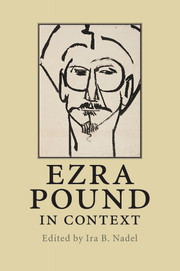Book contents
- Frontmatter
- Contents
- Notes on contributors
- Acknowledgements
- Chronology
- List of abbreviations and note on references to The Cantos
- Introduction
- Part I Biography and works
- Part II Historical and cultural context
- 16 The classics
- 17 Provençal and the troubadours
- 18 Dante and early Italian poetry
- 19 America
- 20 Venice
- 21 London
- 22 Paris
- 23 Rapallo and Rome
- 24 Pisa
- 25 Imagism
- 26 Vorticism
- 27 Music
- 28 Visual arts
- 29 Confucius
- 30 The Orient
- 31 Little magazines
- 32 Publishing and publishers
- 33 Modernism
- 34 Fascism
- 35 Anti-Semitism
- 36 Gender and sexuality
- 37 Race
- 38 Travel
- Part III Critical reception
- Further reading
- Index
23 - Rapallo and Rome
Published online by Cambridge University Press: 05 July 2014
- Frontmatter
- Contents
- Notes on contributors
- Acknowledgements
- Chronology
- List of abbreviations and note on references to The Cantos
- Introduction
- Part I Biography and works
- Part II Historical and cultural context
- 16 The classics
- 17 Provençal and the troubadours
- 18 Dante and early Italian poetry
- 19 America
- 20 Venice
- 21 London
- 22 Paris
- 23 Rapallo and Rome
- 24 Pisa
- 25 Imagism
- 26 Vorticism
- 27 Music
- 28 Visual arts
- 29 Confucius
- 30 The Orient
- 31 Little magazines
- 32 Publishing and publishers
- 33 Modernism
- 34 Fascism
- 35 Anti-Semitism
- 36 Gender and sexuality
- 37 Race
- 38 Travel
- Part III Critical reception
- Further reading
- Index
Summary
RAPALLO AND THE OCCASIONS OF THE CANTOS
Pound lived mostly in and near Rapallo, just south of Genoa, from 1924 to his death, and this place and its landscape permeated his mature poetry. In Cantos xvii–xxx we find many Mediterranean settings in which Odysseus and his avatars rest from their voyages, and the theme is repeated in the “fertility Cantos” of the 1930s, especially xxxix, xlvii, and xlix, where Pound creates his own rituals out of old Rapallo customs (the “sepulchres,” i.e., floral church decorations, of Maundy Thursday, the lights floated in the bay on summer nights). Pound wanted to evoke a true religion of the people, beyond (or before) Judaism and Christianity, and used the material at hand, for example, Christian ceremonies, that looked as if they may well have derived from pagan customs.
In the 1920s Rapallo provided the model for an aesthetic pleasance, in the 1930s the backdrop for a more strenuous “totalitarian” vision, a religion of sexuality, abundance, and fertility. In the 1940s it became the lost paradise of The Pisan Cantos, that shuttle throughout between the beautiful Pisan landscape and memories of the Tigullio (as the Bay of Rapallo is called), where Pound had passed the greater part of his maturity.
- Type
- Chapter
- Information
- Ezra Pound in Context , pp. 250 - 260Publisher: Cambridge University PressPrint publication year: 2010
- 1
- Cited by

